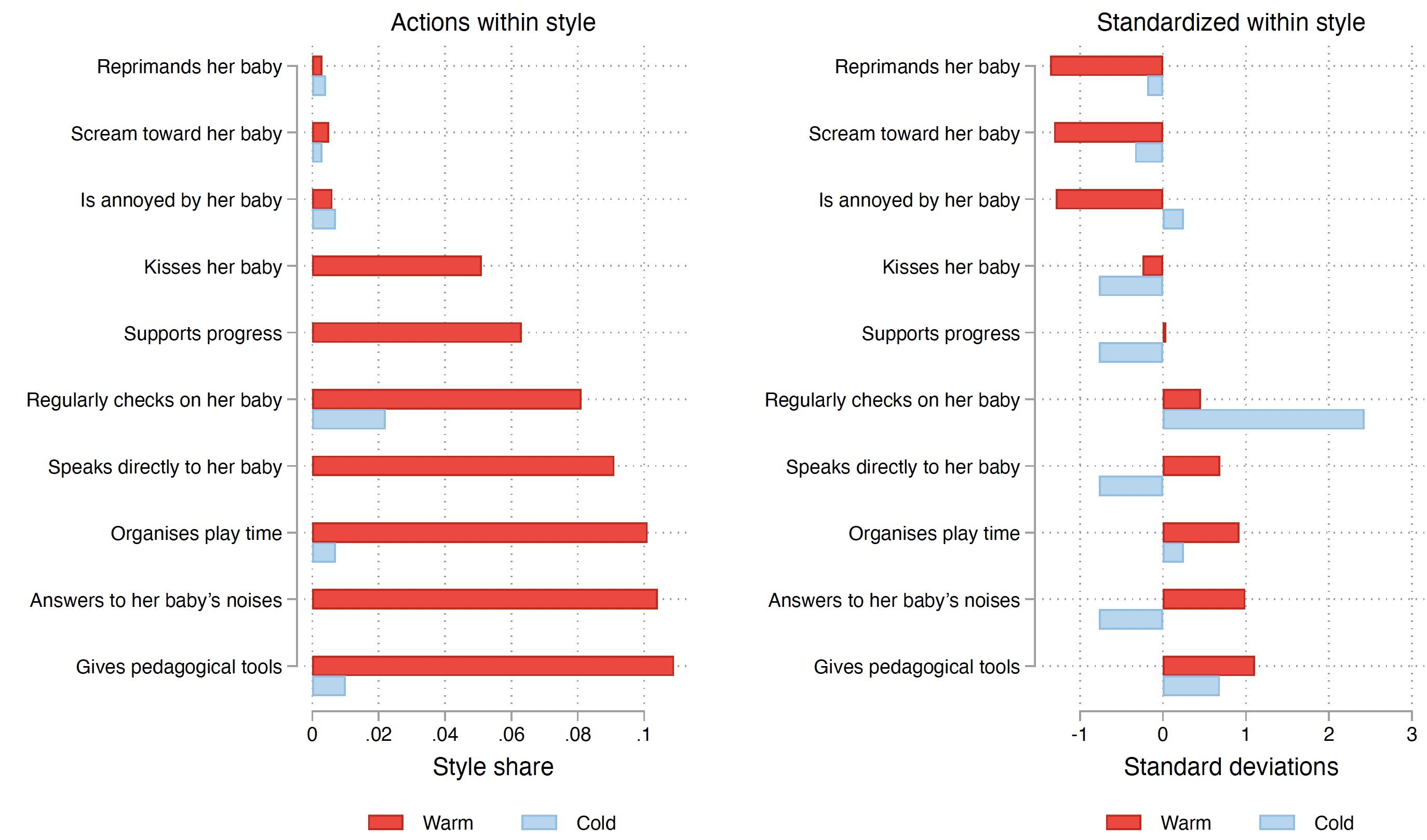How should we raise our children? Research has shown that the amount of parental time invested is not the only crucial element for children’s skill development (Del Boca et al. 2014, Attanasio et al. 2016); parenting style also matters (Fiorini and Keane 2014). Parenting style is a strategic choice linked to incentives (Doepke and Zilibotti 2014). In order to study the relationship between parenting style and child development, researchers rely on ad hoc perceptions or previous research in order to restrict the complexities of parenting to certain key actions. For instance, reading to children has been found to be highly predictive of children’s skill development (Kalb and Jan van Ours 2013). But how can we measure parenting styles without relying on prior beliefs?
In a recent paper (Rauh and Renée 2022), we take an approach that lets the data speak. We adopt a model from computational linguistics to ascertain which sort of parenting styles exist and are the most salient. The original objective of the machine learning algorithm is to learn from the co-occurrence of words and form topics around them. In the context of parenting styles, the idea is that parents who engage in one activity might be more likely to engage in some other given activity such that the algorithm learns from the co-occurrence of parental actions to define two or more parenting styles.
Data
We rely on the Québec Longitudinal Study of Child Development (QLSCD), a detailed panel of a representative sample of families from Québec, a province in Canada, with a baby born between October 1997 and July 1998. We use information on mothers’ behaviours collected across three waves conducted when the target children were 5, 17, and 29 months old.
One advantage of the dataset is that the behaviour of mothers towards their children is not captured through self-reported survey questions, but through the enumerator. At the end of every interview, the enumerator records ten variables classifying whether the mother engages in certain actions during the interview. This leaves the data less susceptible to a bias that can result from mothers misreporting how they behave towards their children.
In Table 1, we see the list of ten activities and what percentage of mothers engages in them during the three interviews. Two things stand out. First, parents overall are more likely to be supportive by affirming progress or kissing and hugging the child rather than screaming at the child or expressing annoyance. Second, despite this imbalance appearing in all three survey waves, there is a considerable shift towards more punitive and less supportive actions as the child ages.
Table 1 Parental actions across survey waves
Notes: The table describes the behaviour of the respondents and their interactions with their children during the annual QLSCD interview in terms of percentages. Behaviours are evaluated by the enumerator during the interview.
Parenting styles
The model we use to classify parenting styles is the Latent Dirichlet Allocation (LDA) developed by Blei et al. (2003) for the classification of text to topics. In recent work, economists have used LDA to determine salient CEO behaviours (Bandiera et al. 2020) and political ideologies (Draca and Schwarz 2021). In our case, each parenting style is defined by the likelihood of each parental action, and parents are classified into two styles. The classification is not ‘strict’ in the sense that parents can be a mix of the two types: the algorithm assigned shares of each style to parents in the dataset.
In Figure 1, we show the resulting distribution of parental actions when classifying parenting into two styles, A and B. The red bars indicate the prevalence of a given action amongst parenting style A and the blue bars amongst parenting style B. The left panel displays the probability of each of the ten actions within a topic. A parenting style should be imagined as an urn from which a parent draws actions. A mother following parenting style A is going to close her eyes and draw an action from the red bars. She will most likely draw the largest bars; for instance, she might hand a pedagogical toy to her child or respond to her baby’s noises. A mother of parenting style B will most likely not draw any action when drawing from the blue bars in the urn because they are so small. In other words, parenting style B is characterised by inaction. Based on these distributions of actions, we follow developmental psychologists McCoby and Martin (1983) and label parenting style A as ‘warm’ and parenting style B as ‘cold’. In the right panel of Figure 1, we see the standardised relative prevalence of a given action within a parenting style. We see that warm mothers are relatively unlikely to reprimand or scream at their child. Cold parents, if anything, simply check on their child.
Figure 1 Distribution of actions by parenting style
Notes: The left panel describes the topic share of actions for each of the two parenting styles. The right panel shows the standardised importance of an action within a style by setting the mean to 0 and the standard deviation to 1.
Are all parents equally likely to follow a warm parenting style? To answer this question, we look at the correlation between warm parenting and parental and family characteristics. In Figure 2, we see the distribution of parenting styles by maternal education. In the left panel, we see that amongst less educated mothers with at most a high school education, the cold parenting style is quite likely. This is indicated by the mass to the left of the graph. If we look at the panel on the right, we see the opposite for mothers with a college degree. For highly educated mothers, there is a shift in the distribution to the right; they are more likely to follow a warm parenting style. We also find that younger mothers and those with more children are more likely to engage in a cold parenting style.
Figure 2 Distribution of styles by maternal education averaged across waves
Notes: The transparent bars represent the binned probabilities of the probability of engaging in a warm rather than a cold parenting style, while the solid line is the kernel density. The sample is the pooled sample in which each parent appears three times.
Table 1 indicated that styles change over time. While there is some persistence – that is, mothers with a warm style are more likely to continue to follow a warm style and those with a cold style are more likely to continue a cold style – there are also systematic shifts as the child ages. On average, parenting styles become colder. The other remarkable shift is that, while at 5 months there is no difference between parenting styles towards boys and girls, by the time the child reaches 29 months, boys are statistically more likely to face a cold parenting style.
Do parenting styles affect skill development?
While we cannot provide a definite answer to this question due to a lack of exogenous variation, we can look at whether children exposed to certain parenting styles achieve higher skill levels at later ages. More specifically, we look at summary measures of cognitive test scores (such as math or logic) and non-cognitive scores (such as behavioural disorders or hyperactivity) at age 6.
In Figure 3, we show the impact of warm parenting on the standardised skill measures at age 6. We show the relationship for parenting styles measured at each age separately (top) and for an aggregate measure of style calculated across the three ages (bottom). We see that children exposed to a fully warm parenting style rather than an absolutely cold parenting style at 5 months achieve cognitive skills (left) that are more 0.3 standard deviations greater and non-cognitive skills (right) that are more than 0.2 standard deviations higher. The effect sizes of parenting styles at the age of 5 months are greater than at ages 17 and 29 months even though the parenting style is measured the furthest away from the outcome when the child is 6 years old. This provides some support for the idea that very early childhood investments are of particular importance.
Figure 3 Coefficients from regressing warm parenting on cognitive and non-cognitive skills at age 6 years
Notes: The dependent variable is computed by taking the first factor of six measures of each, cognitive and non-cognitive ability, at 6 years old. The score is standardised with a mean zero and a standard deviation of one. The thin lines represent the 90% confidence interval.
The aggregate measure of parenting styles exhibits an even higher correlation with outcomes. Warm parenting is associated with more than half a standard deviation higher cognitive skills, and a one-third standard deviation higher non-cognitive skills.
Looking ahead
Given the exponential growth of available data, we should leverage machine learning in order to gain a better understanding of what sort of parenting ‘works’. Letting the data speak allows us to challenge traditional assumptions and uncover patterns of success. This could help policymakers and researchers design interventions and support programmes to help parents navigate the complexities of raising children and avoid the ‘parent trap’ (Hilger 2022).
References
Attanasio, O, S Cattan and S Krutikova (2016), “Early childhood development policies: The evidence and the research agenda”, VoxEU.org, 09 June.
Bandiera, O, A Prat, A Hansen and R Sadun (2020), “CEO behaviour and firm performance”, Journal of Political Economy 128(4): 1325–1369.
Blei, D M, A Y Ng and M I Jordan (2003), “Latent Dirichlet allocation”, Journal of Machine Learning Research 3: 993–1022.
Del Boca, D, C Flinn and M Wiswall (2014), “Household choices and child development”, Review of Economic Studies 81(1): 137–185.
Draca, M and C Schwarz (2021), “How Polarized are Citizens? Measuring Ideology from the Ground-Up”, SSRN, 11 May.
Doepke, M and F Zilibotti (2014), “Tiger moms and helicopter parents: The economics of parenting style”, VoxEU.org, 11 October.
Fiorini, M and M P Keane (2014), “How the allocation of children’s time affects cognitive and noncognitive development”, Journal of Labor Economics 32(4): 787–836.
Hilger, N G (2022), The Parent Trap: How to Stop Overloading Parents and Fix Our Inequality Crisis, MIT Press.
Kalb, G and J van Ours (2013), “Reading to children: a head-start in life”, VoxEU.org, 10 June.
McCoby, E and J Martin (1983), “Socialization in the context of the family: Parent-child interaction”, Handbook of Child Psychology 4: 1–101.
Rauh, C and L Renee (2022), “How to measure parenting styles?”, CEPR Discussion Paper 17326.







